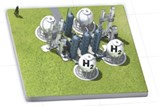Automation Of Power-To-Gas Plants

The field of renewable energy is facing new challenges especially regarding the expansion, integration and management of power generation. These challenges concern the generation, transportation, trading, distribution and, most importantly, the storage of electrical energy. One promising solution is to store it chemically in the form of hydrogen and methane. In what are known as power-to-gas plants, hydrogen is first produced from surplus electricity generated from renewable resources. In a subsequent step, it can then, for instance, be converted into methane and fed into the existing natural gas grid. The Siemens Industry Automation Division provides integrated and tailor-made automation solutions based on the Simatic PCS 7 process control system which help optimize the production process and the efficiency of such plants.
All subsystems and field devices, such as Sitrans flow meters, are integrated into the system. The data transparency created in this way makes it possible to efficiently run the plant throughout its entire life cycle. Efficiency is also promoted by the large number of diagnostic functions included in Simatic PCS 7. All plant data and documents are organized in a central engineering database which can also be used by subsystem suppliers. This significantly reduces the time needed for planning and commissioning and, hence, time to market. The system's scalability ensures the rapid and smooth translation of findings gained in a pilot plant to a large-scale plant.
Storage technologies play a key role in the field of renewable sources of energy: Solar and wind energy do not supply power during darkness or in calm weather, while producing more than is needed at peak times. Power to gas plants help convert surplus generated power to be stored for later use.
Source: Siemens
